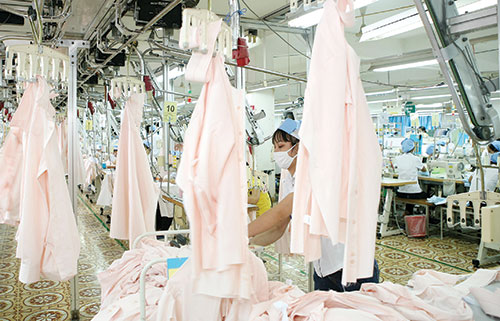TPP offers apparel deal

Vietnam’s garment manufacturers could capitalise on the Trans-Pacific Partnership dealPhoto: Le Toan
Vietnam is currently negotiating the so-called ‘yarn forward’ principle under the Trans-Pacific Partnership (TPP) expected to be concluded next year. Under the proposed rule, for Vietnamese textile exporters to enjoy 0 per cent import tax, instead of the existing 17-20 per cent, on exports to the US, the entire manufacturing process, including yarn spinning, knitting and dyeing must be carried out in a TPP member country.
The TPP, a strategic alliance aimed to further liberalise Asia-Pacific economies, features the membership of the US, New Zealand, Brunei, Chile, Vietnam, Singapore, Australia, Peru, Malaysia, Canada, Mexico and Japan.
According to Viet Capital Securities Company’s July report on the TPP, if the proposed ‘yarn forward’ rule is applied, it would help Vietnam attract more foreign makers of fibre, cloth and apparel to build factories to provide materials for Vietnam-based garment and textile firms. This would present major change, as these companies presently have to import 80 per cent of their input materials from China, Taiwan and South Korea, which are non-TPP members.
On July 10, 2013, China’s Texhong Textile Group began operation of its $200 million first phase of fabrics plant, while the $400 million second phase of the plant will become operational in Vietnam next year
In June 2013, South Korea’s Hyosung, the world’s largest spandex producer announced plans to expand its production facility of creora brand spandex in the country’s southern province of Dong Nai. Phase 1 and 2 will come online in August and November 2013, respectively.
This was to better serve demand in South East Asia, and in anticipation of the TPP approved “yarn forward” rule coming into effect, said Hyosung’s president CH Lee Hyosung.
TAL Hong Kong Development Company’s director Roger Lee recently said that his group wanted to expand its investment in Vietnam with an additional $200 million, from the existing $40 million factory established in 2004, to make fabrics, garments and textiles, thanks to the duty savings it could receive under the TPP.
In early May 2013 South Korea’s textile and garment maker KyungBang inaugurated its $40 million high-quality cotton yarn factory with 25,920 spindles in the southern province of Binh Duong. When the investment is extended in its second and third phase, with the registered investment of $160 million, it will be the largest plant of its kind in Asia.
Last year, Tian Nan, a Chinese-Vietnamese textile and dyeing joint venture, was established to develop a $24 million cloth making project in the northern province of Nam Dinh.
“When these factories come into full operations, other textile and garment firms will be able to source input materials in Vietnam, and meet the “yarn forward” rule,” said Dinh Thi Nhu Hoa, a Viet Capital Securities Company senior analyst.
The US and Japan are major importers of Vietnamese garments and textiles, representing 55 and 12 per cent of the country’s total exports respectively.
What the stars mean:
★ Poor ★ ★ Promising ★★★ Good ★★★★ Very good ★★★★★ Exceptional
Latest News
More News
- Vietnam's IFC to target global investment flows (December 21, 2025 | 18:00)
- Two national hospitals expand capacity with new facilities (December 20, 2025 | 09:00)
- Ha Tinh breaks ground on major Vingroup industrial and energy projects (December 19, 2025 | 18:24)
- EVN launches major power infrastructure projects nationwide (December 19, 2025 | 18:17)
- VAL inaugurates second production line to meet domestic animal feed demand (December 19, 2025 | 16:37)
- Sun Group pioneers urban tram system in Phu Quoc (December 19, 2025 | 15:00)
- Seven major projects launched to drive Hanoi’s next growth phase (December 19, 2025 | 14:00)
- Securing capital and efficiency for Vietnam’s 2026-2030 growth ambitions (December 17, 2025 | 10:00)
- Vietnam bucking trend in the global M&A landscape (December 16, 2025 | 14:20)
- HDS Summit spotlights Vietnam’s rising role in regional supply chains (December 16, 2025 | 08:00)

















 Mobile Version
Mobile Version